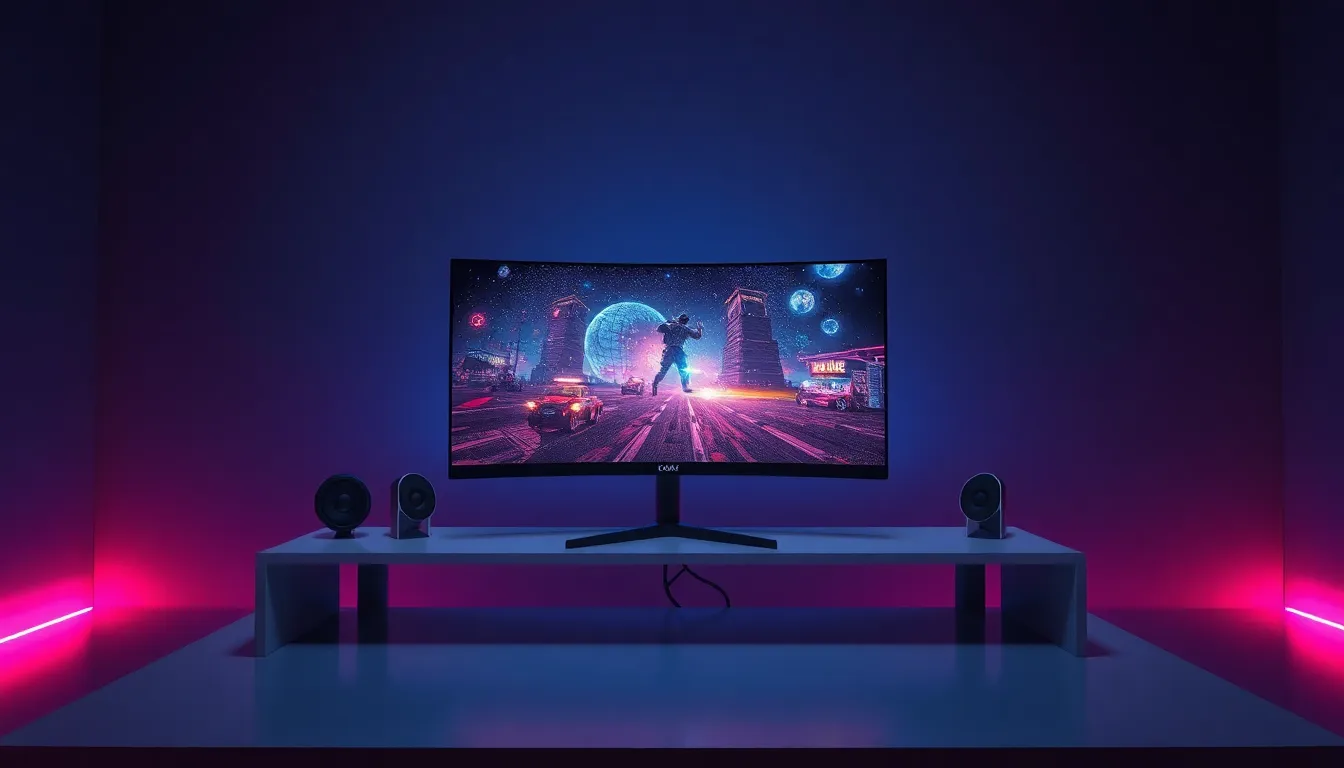Curved monitors have taken the gaming world by storm, promising an immersive experience that straight screens just can’t match. Imagine being wrapped in your game, feeling every twist and turn as if you’re right in the action. It’s like upgrading from a flip phone to the latest smartphone—once you go curved, you might wonder how you ever lived without it.
Table of Contents
ToggleBenefits Of Curved Monitors For Gaming
Curved monitors offer several advantages that enhance the gaming experience. Gamers notice significant improvements in immersion, viewing angles, and comfort, making these displays increasingly popular.
Immersive Experience
Curved monitors create a wrap-around effect that draws players into the game environment. This design naturally complements the human field of vision, improving depth perception. The immersive experience allows players to feel more engaged in action-packed sequences. A curved screen minimizes distractions by focusing attention on the center of the display. Gamers also appreciate the architectural design that encourages a more exciting gameplay experience.
Enhanced Field Of View
An expanded field of view enhances overall gaming performance. Curved displays enable peripheral vision to remain engaged, keeping players aware of their surroundings. This feature proves beneficial for first-person shooters and open-world games. Curved monitors reduce image distortion, ensuring clarity across the screen edges. Gamers enjoy a more comprehensive visual spectrum, crucial for strategic decision-making during gameplay. Overall, the enhanced field of view tends to improve player reaction times and situational awareness.
Reduced Eye Strain
Eye strain often results from long gaming sessions, but curved monitors help alleviate this issue. The curvature allows for a more natural viewing angle, decreasing the need for eye repositioning. Players frequently report less fatigue during extended use, making gaming more enjoyable. Curved displays often feature advanced technologies that support eye comfort, such as flicker-free screens and blue light filters. Gamers benefit from prolonged comfort, thus improving their overall gaming experience.
Drawbacks Of Curved Monitors

Curved monitors present some challenges for gamers that warrant consideration. These drawbacks include aspects such as cost, viewing angles, and compatibility.
Cost Considerations
Purchasing a curved monitor often demands a higher investment compared to flat models. Many options in the market come with premium price tags; the better the specifications, the more significant the cost. Budget-conscious gamers might find it challenging to locate models that meet their needs without compromising on quality. Investing in a curved monitor means weighing the price against the expected benefits. While the immersive experience enhances gameplay, the upfront costs might deter those on a tight budget.
Limited Viewing Angles
Limited viewing angles pose another concern for curved monitors. When a viewer steps outside the optimal sweet spot, image quality often diminishes. Diminished brightness and color accuracy often occur when the screen is viewed from extreme sides. Gamers frequently sitting in varied positions may experience this issue, making game visuals less impressive. Selecting a curved monitor also requires thoughtful consideration of viewing distances, as the curvature may not suit every gaming setup. Distorted visuals can diminish the overall gaming experience, leading to frustration.
Compatibility Issues
Compatibility issues frequently arise with curved monitors during setup and use. Some older graphics cards may not support optimal resolutions, leading to subpar performance. Gamers with multiple-monitor setups often struggle to align curved monitors with flat screens, creating an uneven visual experience. Furthermore, certain games may not render well on curved displays, introducing unintended artifacts. Ensuring full compatibility with both hardware and software can complicate the transition to a curved monitor. Careful research into specifications remains essential to avoid disappointments.
Comparing Curved And Flat Monitors
Curved and flat monitors offer distinct features that may impact gaming performance and user experience. Understanding these differences can help gamers choose the right setup.
Performance Metrics
Performance metrics can vary significantly between curved and flat monitors. Curved models often provide improved immersion, particularly in competitive gaming genres. They expand the field of view, which can enhance response times, especially in first-person shooter games. On the other hand, flat monitors usually excel in color accuracy and consistency, making them favorable for graphic-intensive applications. Refresh rates and response times remain crucial factors, influencing gameplay smoothness. Gamers seeking higher refresh rates may find that flat displays generally come with more options. Thus, knowing the specific gaming requirements guides gamers toward the ideal monitor choice.
User Preferences
User preferences play a vital role in the selection process between curved and flat monitors. Many gamers appreciate the wrap-around effect offered by curved displays, which enhances immersion during gameplay. Conversely, some individuals prefer the familiar experience provided by flat monitors, particularly for traditional desktop tasks. Personal comfort often drives this decision, especially for those who engage in long gaming sessions since curved designs tend to reduce eye strain. Compatibility also influences user choices, with some gamers favoring flat monitors for easier integration into existing setups. Recognizing personal priorities aids in finding the most suitable monitor for gaming.
Popular Curved Monitor Options
Curved monitors come in various models catering to different preferences and budgets. This section highlights both high-end choices and budget-friendly models suitable for gamers.
High-End Choices
Top-tier brands like Samsung and Dell offer premium curved monitors featuring advanced technologies. Samsung’s Odyssey series provides impressive resolutions such as 1440p and 4K, enhancing visual clarity and immersion. Dell’s Alienware line boasts ultra-fast refresh rates, ideal for competitive gaming with minimal lag. Often equipped with G-Sync or FreeSync, these monitors minimize tearing and stuttering, ensuring a smooth experience. All these elements create a competitive edge in gaming environments.
Budget-Friendly Models
Affordable options also exist for gamers not looking to break the bank. Brands like AOC and ViewSonic deliver reliable curved monitors under $300 without sacrificing essential features. AOC’s C24G1, for example, provides a 144Hz refresh rate and a 1080p resolution, making it suitable for fast-paced games. ViewSonic’s VX2458-C-MHD offers similar performance at a competitive price point, ensuring decent color accuracy and performance. These models highlight the possibility of enjoying curved displays even on a budget while maintaining an engaging gaming experience.
Curved monitors present a compelling option for gamers seeking an immersive experience. Their ability to enhance depth perception and engagement can transform gameplay, particularly in fast-paced genres. While the benefits of comfort and reduced eye strain are significant, potential drawbacks like cost and compatibility issues shouldn’t be overlooked.
Gamers must assess their individual preferences and gaming habits to determine if a curved monitor aligns with their needs. With a range of options available from high-end to budget-friendly, there’s a curved monitor for almost every gamer. Ultimately, the choice between a curved and flat monitor hinges on personal priorities and the desired gaming experience.







